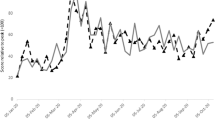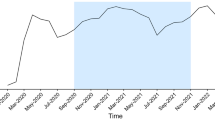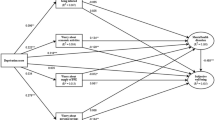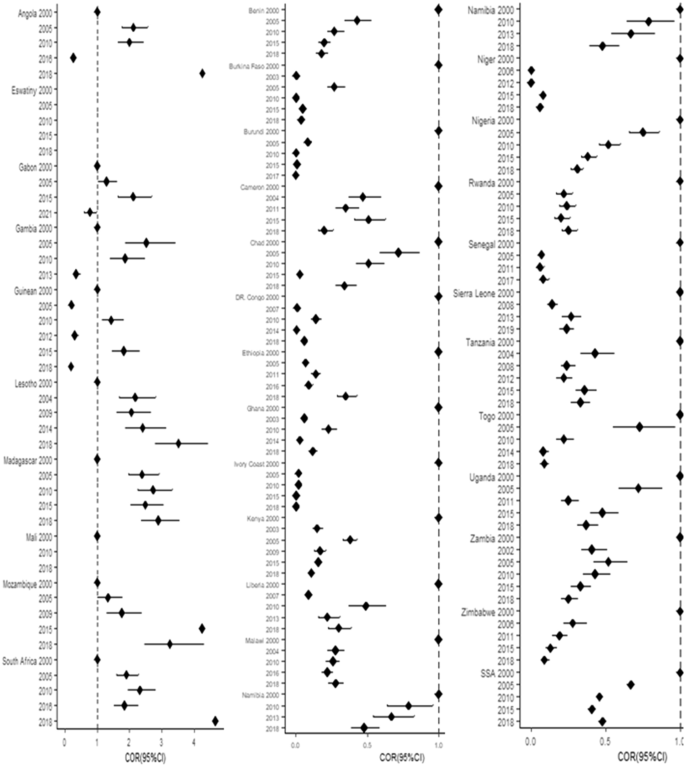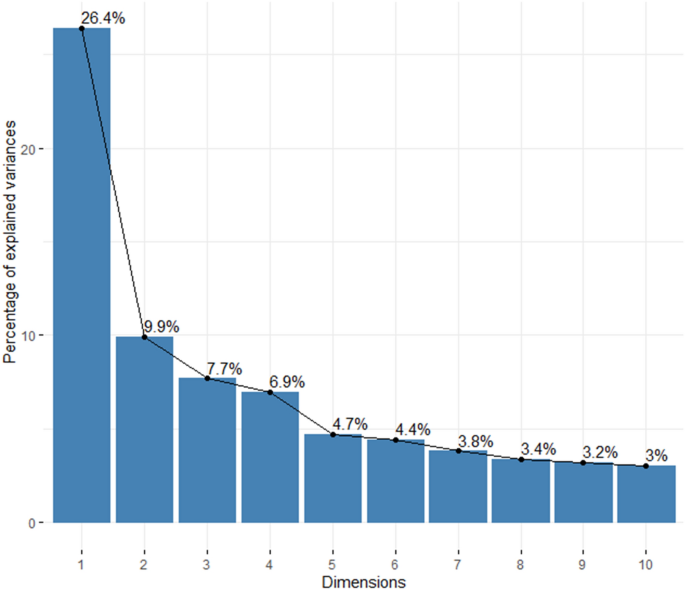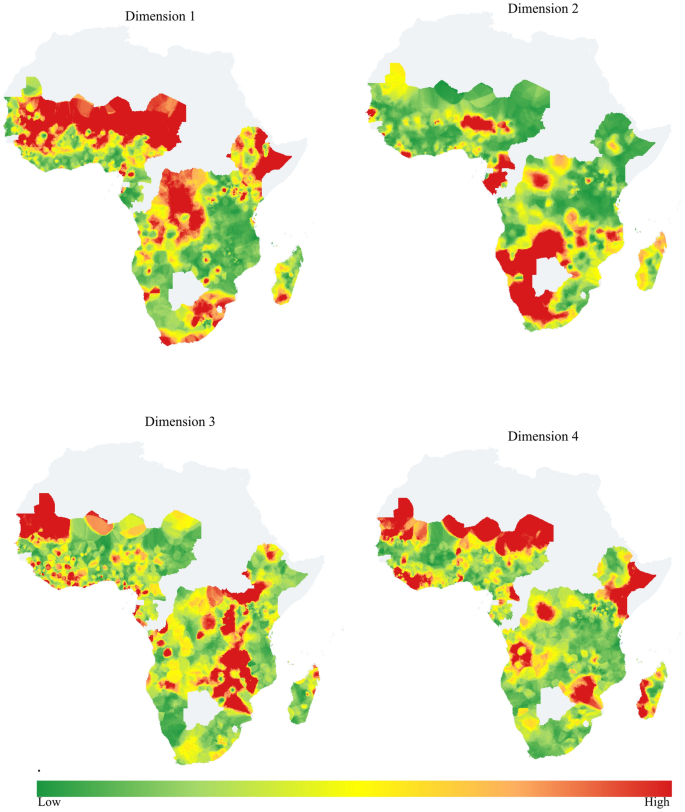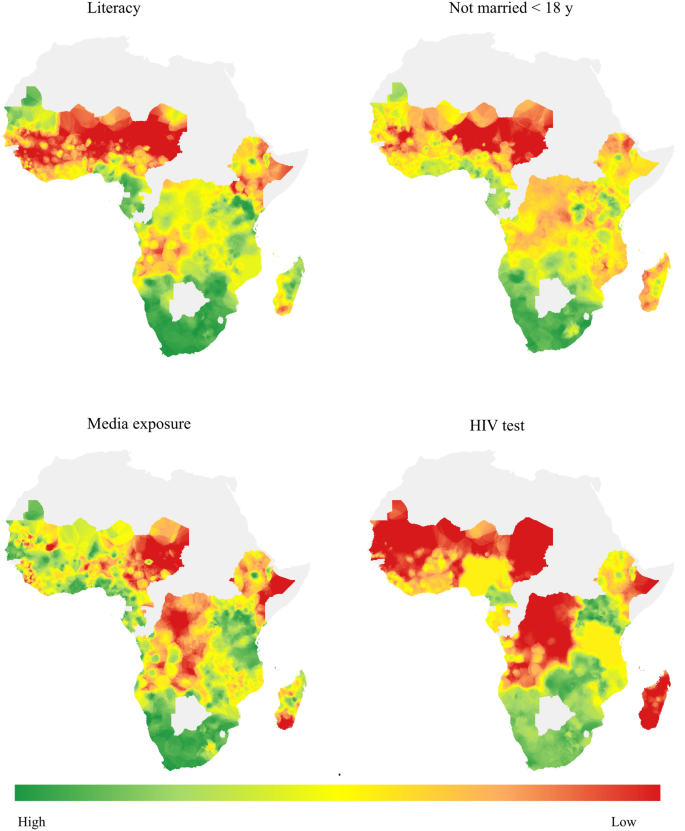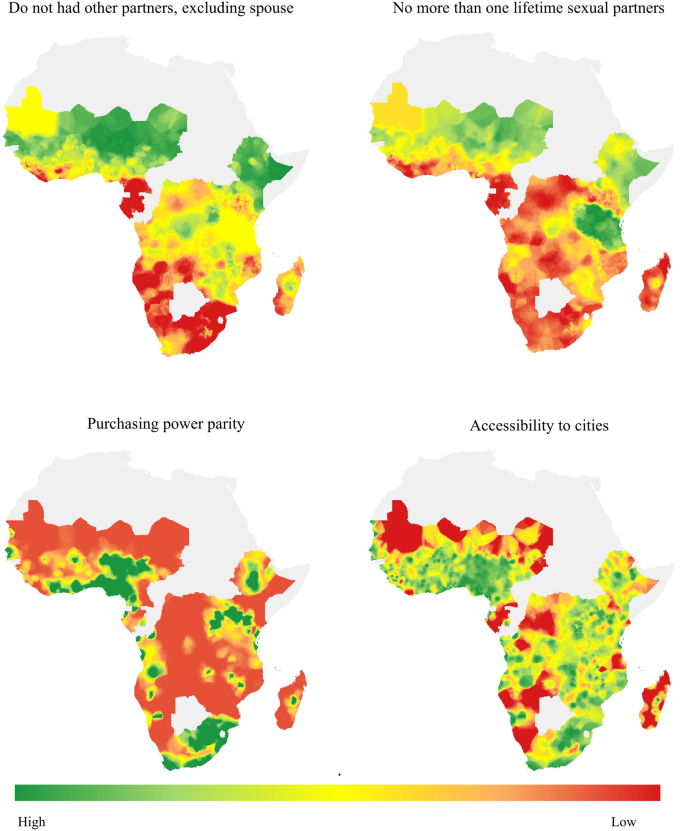Abstract
This study aimed to identify the most important principal components (PCs) that contribute to the prevalence and change of HIV/AIDS in 44 SSA and data from different national and international datasets. The study estimated HIV prevalence, trend, and principal component analysis (PCA). Using the elbow method, the number of important PCs and contributions was identified. The quality of representation was checked, and more contributing variables for most important PCs were identified. Finally, the status by prevalence, the progress by trend, the more influenced component by PCA, and the more influenced variable with quality of representation by PCs were reported. The study found that HIV prevalence varied significantly, with 30 of the countries showed good progress/decline. Four PCs accounted for 51% of the total variance. Literacy, cohabitation, media exposure, and HIV status awareness are highly contributing factors. Based on these findings, a gap-based response will help reduce the burden of HIV.
Similar content being viewed by others
Introduction
Since the beginning of the first decade of the twentieth century, there have been several landmark events in global efforts to advance HIV/AIDS response. These include the Ryan White Comprehensive AIDS Resources Emergency in 19901, the red ribbon symbol of AIDS in 19912, the establishment of The Joint United Nations Programme on HIV/AIDS in 19963, antiretroviral therapy was introduced in 19964, goal was set to halt the spread of HIV/AIDS by 20155, the President’s Emergency Plan for AIDS Relief was launched in 20036.
In 2015, the world delivered on the AIDS targets of Millennium Development Goal 6—halting and ensuring healthy lives7 and promoting well-being for all at all ages8. In 2016, The United Nations General Assembly adopted the Political Declaration on Ending AIDS, which set new targets for 2020 and 20309. In 2018, UNAIDS launched the “Miles to go—closing gaps, breaking barriers, righting injustices” report, which highlighted the progress made in the global response to HIV/AIDS and identified areas where more work is needed10. In 2019, the World Health Organization (WHO) recommended that people at high risk of HIV infection should be offered pre-exposure prophylaxis11. In 2020 and 2021, there were many long efforts to end the HIV epidemic globally and domestically12. However, in 2022 UNAIDS said that we are “IN DANGER”13.
Globally, HIV infection has declined annually from 2010 to 2022. However, around two-fifths of the region experienced an increase in HIV infection14. Sub-Saharan Africa (SSA) is home to two-thirds of all people living with HIV globally and is the hardest-hit region in the world14. While HIV varies across countries15,16,17 and within countries18,19, this heterogeneity has been explored to some extent. Each community contributes to a specific component, and the factors that influence each community more than their neighbors, the progress over time potential components and influenced variables on the most relevant components do not have been explored at all. This work clearly shows the prevalence, change over time, each community/variable contribution for the specific component, and the highly influenced variable in each component by community. Due to culture, economy, and other reasons, the way of response differs from one area to another area. Programmers, policymakers, and other concerned bodies can make more reduction efforts based on their problem. This analysis clearly showed what the progress is, where is the problem more happening and what the potential reason is clearly set.
Methods
Overview
The objective was to identify and obtain individual/community-level data from all repeated nationally representative Demography and Health Survey (DHS), Malaria Atlas Project, NASA Socioeconomic Data and Applications Center (SEDAC), Global Health Data Exchange (GHDx), and sentinel surveillance of antenatal care clinics (ANC data) that included information on HIV/AIDS status and/or other intervention areas. A maximum of 44 countries were included based on conditions, reducing some countries in some analyses. For example Zimbabwe included in the trend, PCA, community, and national prevalence. South Sudan, Mauritius, Equatorial Guinea, and Botswana included only in national prevalence analysis but not included in other analysis.
For HIV analysis, data from DHS and GHDx were used20,21, which are highly comparable and nationally representative. DHS is one of the main publicly available sources of information for low-income and middle-income countries. Given their focus on adult HIV tests, these surveys target both women and men aged 15–49 years. SSA was selected because most of the countries have conducted at least one HIV test result or geospatial coordinate, and 15 of them collected data from 2015 to 2021 by DHS, almost all of them estimated by GHDx in 2018, and in 2021 by ANC sentinel22 (Supplementary Figs. 1–3; Supplementary Table 1). The ethical responsibility for all data sources included in this study lies with the institutions that conducted the surveys in each country; therefore, ethics approval for this study was not required.
Data management and analysis
This analysis presents community-based prevalence from 2015 to 2021, country-level prevalence in 2021, and the change over time from 2000 to 2018 (some countries extended to 2021) in Sub-Saharan Africa. The period of 2000–2021 and the age group of 15–49 years were selected to maximize data availability, and most countries’ data sources focus on the 15–49 years age range as the most commonly reported age range. Trend in the form of regression ordinal logistic models were implemented. In this analysis, the data is converted into the prevalence of enumeration areas or communities but for this purpose converted to an ordinal model. Cluster-level HIV prevalence was recategorized into quartiles, where the first quarter is the lowest prevalence and the fourth quarter is the highest prevalence.
For Principal Component Analysis (PCA), only countries that had standard DHS data with GIS coordinate/shape file data information at least once since 2012 were included. Based on DHS coordinate data, extract the cluster value from other sources of data.
This analysis used community-based geographic coordinates (point) data rather than polygon (administrative areas) for HIV prevalence analysis. In point data, the value of HIV prevalence is shared country to country across the border. For this reason, the different years of data collection of each country could be influenced by other neighbors. To control the time variation of data collection, I adopted the country in which HIV test data was collected since 2015 from DHS and the rest from the 2018 GHDx. The country-level prevalence is data from sentinel surveillance of antenatal care clinics (ANC data). ANC data were primarily derived from national HIV estimate files developed by national teams and compiled and shared via UNAIDS. Therefore, I used final UNAIDS compiled data of 202122. For change over time, used both DHS and GHDx data. For community-based change over time, I used GHDx raster data of 2000, 2005, 2010, and 2018. For country-based trend (change over time) regression analysis, all DHS datasets since 2000 which have HIV test results included were used. If the country did not have data or enough data within the 5 years of interval extracted from GDB raster data based on the most recent GPS coordinates of DHS (Supplementary Fig. 4).
This analysis included 27 pre-existing covariates from different sources, such as DHS20, Atlas Malaria project23,24,25, NASA socioeconomic data26,27,28,29,30,31, and GHDx32. Extracting the important information from multivariate data from different datasets to express this information as a set of few new important variables and the most important variables helps combat HIV and other similar problems to achieve 2030 goals. For this analysis, PCA was used. For PCA analysis, variables from DHS individual-level variables changed to community prevalence, and variables from other sources were extracted based on those community-based coordinate datasets. In general, 19,546 point data from 34 countries with 27 variables from four different datasets were extracted (Supplementary Fig. 2; Supplementary Table 1).
Due to the sensitivity of PCA for outliers, the outlier is identified using a boxplot. It is treated by replacing the outlier with a value that is close to the outlier but not as extreme (winsorization). If the outlier is extreme and cannot be treated by the winsorization method, first reduce the effect by using log transformation and finally use winsorization (Supplementary Fig. 3).
All variables are continuous but the effects were found in different dimensions. Some variables are disadvantaged by lower values, while others are inverse. To control this problem and put it into the same dimension (more negatively influenced by higher value), it is transformed by multiplying -1. The variables were from different sources and had different units of measurement. Due to this reason modifies by harmonizing its variability in all directions of the original vectors or standardizing the variables.
To obtain the results of PCA, the eigenvalues/variance and its percent obtained in each principal component are extracted and visualized. The eigenvalues are plotted according to their size (scree), and the elbow point is identified, which is the point where the slope of the graph goes from steep to flat. The components before the elbow are kept, which is determined by looking at an elbow shape of Scree Plot, which is the plot of eigenvalues ordered from largest to smallest33,34,35.
The quality of representation (cos2) of both variables and observations/clusters to each PCs were identified. The contributions of variables and clusters in accounting for the variability in a given PCs are expressed. The most significantly associated variables (according to their contributions) with a given principal component are identified by dimension description. All flow from data extraction to data analysis see the flow chart in the supplementary material (Supplementary Fig. 4).
This analysis do not use of experimental animals, or human participants and I use only global/national open source data. So, institutional and/or licensing committee approval for this study was not required.
Analyses were conducted using STAT for data management R for statistical computing (Outlier, PCA, graph, regression), and SAGA and QGIS (Interpolation).
Ethical approval
The utilized DHS data sets are publicly available, and the DHS Programme de-identifies all data before making them available to the public. All other geospatial data sources and DHS do not contain variables at the level of human subjects. Therefore, this work did not require ethical approval.
Results
HIV prevalence varied significantly at the community level and among countries throughout Sub-Saharan African countries. This variation indicated that every country had both edges of HIV prevalence within their communities or grid cells. Within countries, some had a relatively high overall HIV prevalence (e.g., Lesotho, Botswana, and South Africa). Out of 44 countries, except 10 countries have shown good progress or decline in HIV prevalence since 2000 (Fig. 1; Supplementary Figs. 5–7).
HIV trend in SSA. HIV change over time of each countries by year multilevel logistic regression compared by crude odds ratio (COR). To conduct this analysis use R version 4.3.2, available at: https://cran.r-project.org/bin/windows/base/.
In Sub-Saharan Africa, HIV has declined the risk of transition to high severity from the beginning of the first decade of the twenty-first century to the end of the second decade of the twenty-first century. In most countries, decline occurred over time (e.g., Benin, Burkina Faso, Burundi), and in 10 countries it coincided with an increased risk of HIV moving from lower severity to higher severity in the recent time period (e.g., Angola, Lesotho). Some countries like Mali had lower prevalence; the trend indicates increased HIV severity since 2000. Some countries more infected by HIV like South Africa and Lesotho showed increased over time. Change over time based on each grid cell HIV prevalence in Sub-Saharan Africa showed that the change between the first decade of the twenty-first century at the beginning and the end had better achievement compared to the change between the second decade of at the beginning and the end. The southern part of Sub-Saharan Africa was a reverse achievement. Most countries continue as it has neither declined nor increased especially in the second decade of twenty-first century. The southern Sub-Saharan Africa in recent decades is good compared to the first decade but still showed a higher increment in recent decades (Fig. 1; Supplementary Figs. 5–7).
The outcome measurement survey’s construct validity was calculated using PCA. According to PCA, the total of four principal components (PCs) could account for 51% of the total variance (based on the elbow method). The first component expresses 26.41% of data variability, which is 2.66, 3.44, and 3.8 times more variables than the next three components, respectively. The first two components represent 36.32% of the data (Fig. 2; Supplementary Table 2).
The list of variables that quality of representation was checked the most to the first or most influenced component were literacy, cohabitation, media exposure, HIV status, negotiating sex, MER, GDP, stigma, and PPT. These variables contributed 8.9%, 7.62%, 6.99%, 6.77%, 6.53%, 6.47%, 5.74%, 5.21%, and 5.16%, respectively. Literacy alone contributed 8.9%. In the second most influenced component, the number of partners excluding spouse, number of sex partners, PPT, city, MER, GDP, and disaster were the more contributing variables that accounted for 12.65%, 11.31%, 10.61%, 8.96%, 8.36%, 6.57%, and 6.36%. For the third more likely influenced component male circumcision, housing, migration, stigma, HIV test, and mother to child transmission knowledge were contributing variables that accounted for 19.58%, 10.05%, 9.57%, 8.77%, 8.7%, and 6.45% respectively. Working status (15.09%), food insecurity (14.54%), number of sex partners (10.74%), STI (10.33%), and age at first sex (8.34%) contributed to the fourth component. Those variables contributed about two thirds of the corresponding component (Fig. 3; Supplementary Figs. 8, 9; Supplementary Table 3).
The quality of representation of a variable in each principal component is well represented by the principal component. In every principal component separately, the high percentage of variable contributions has high quality of representation by principal components. Almost all the variables listed above contributed to the first component, and male circumcision in the third component was highly represented by its principal component (Fig. 3; Supplementary Fig. 10; Supplementary Table 4).
The list of communities/clusters that contributed the most to the first or most influenced component were the Northern part of West Africa and most areas of DR Congo, Ethiopia, and South Africa. Communities from all areas of Gabon and Southern African countries except the North East direction of South Africa, some areas of Cameroon, Senegal, Nigeria, and Liberia were highly contributing to the second most principal components. The third most influenced components were highly contributed to by Mauritania, Rwanda, Burundi, countries in the southern part of East Africa and northern parts of South Africa, and some countries like Ivory Coast. In the fourth most influenced components, highly contributing communities were the Northern edge of West Africa, most areas of Sierra Leone, Liberia, Mozambique, Madagascar, Kenya and Ethiopia and some areas of other countries like Angola and DR Congo (Fig. 4).
Communities’ contribution of for the selected first 4 PCs (Dimensions). To conduct this analysis use QGIS version 3.28.15 with SAGA GIS version 7.8.2, available at: https://download.qgis.org/downloads/.
The quality of representation of a cluster/community in each principal component is well represented by a principal component. In every principal component separately, the high percentage of community contributions has high quality of representation by principal components (Supplementary Fig. 11).
The four most significant variables contributing to the most important principal components were literacy, cohabitation, media exposure, and HIV status awareness. Most Western SSA and some Eastern SSA countries had a higher prevalence of communities unable to read and write. Except for southern SSA countries, the rest are living with the problem of being unable to read and write. The second most important variable was marital status. Most Western SSA countries of their community pass on unstable lives with partners. That means a higher percentage of the community is either divorced, widowed, or separated. The third important variable that contributed to the first principal components was media exposure. Most communities in central and some areas of Western and Eastern SSA did not have access to radio, television, and newsletters. The fourth was awareness of HIV status. Almost all countries in Western and Central SSA, Madagascar, and some areas of Ethiopia did not know their HIV status (Fig. 5).
The four most significant variables contributing to the second most important principal components were the number of partners excluding spouse, number of lifetime sexual partners, PPT, and accessibility cities. Almost all communities of Southern SSA, Gabon, Cameroon, and Liberia from Western SSA had at least one partner excluding a spouse. Most communities in all areas of Northern, Central, and Eastern SSA except Tanzania, Uganda, Ethiopia and Kenya in the direction of Ethiopia, Western edge of West Africa Gabon to Sera Lion had more and more number of sex partners. Except South Africa, Rwanda, Burundi, Uganda, Nigeria, and some areas of Benin, Togo, Ghana, Ivory Coast, Ethiopia, Kenya, and Angola were under the economic productivity and standards of living or lower productivity and growth. All areas of Mauritania, Chad, Madagascar, Namibia and Gabon, and some areas of Northern part of West Africa, D.R. Congo and others were talking a long time to travel time to cities to assess inequalities in accessibility (Fig. 6).
Discussion
Since the first decade of the twenty-first century, the global community has been working to combat HIV and AIDS. The United Nations Security Council and the U.S. President’s Emergency Plan for AIDS Relief took different actions to respond to HIV and AIDS globally36,37,38. Thanks to an uninterrupted effort on access to antiretroviral therapy, HIV-positive people now live longer and healthier lives and prevent onward transmission, leading to a decline in HIV prevalence and death.
The global community has set interim targets for 2020 and 2025 to help achieve the goal of ending the AIDS epidemic by 2030. The 2020 targets for a declined number of newly infected and AIDS-related deaths were missed39, and this target is extended to 2025 with some improvement in reducing the burden40,41. Considering UNAIDS 202214, achieving the 2025 target will be challenging. We are in the mid-year of the second interim target and now need to take more important action to achieve the target or reduce the gap. This work contributes to showing the path that ends AIDS. Not only does it contribute to HIV/AIDS efforts, but it also contributes to achieving other SDG goals by identifying present analysis and potential for future directions.
The proportion of HIV has declined over time in Sub-Saharan Africa (SSA) and fallen in most countries but increased in others. These analyses show substantial differences between and within countries in levels and trends in HIV prevalence and the spatial distribution of communities living with HIV. Some countries as well as their communities with high prevalence have increased since the beginning of the first decade of the twenty-first century42.
Most communities that contributed to PC1 were found in West Africa, D.R. Congo, Ethiopia, and the Northern part of South Africa. Most areas of West Africa had a higher prevalence of communities unable to read and write and did not know their HIV status. In East parts, there was an additional higher rate of being unable to stay in marriage and low access to media. Most areas of Central and Eastern SSA, especially D.R. Congo, Madagascar, and Ethiopia, had lower media exposure and awareness of HIV status. Efforts on those more significant variables in Western, Central, and Eastern SSA can reduce the gap of SDG goals and achievements not only in HIV/AIDS but also with other most SDG goals.
Most communities that contributed to PC2 were highly infected by HIV. In these areas, the community has more lifetime sexual partners even if they had partners exposed to more additional partners for sexual purposes. In SSA, reductions in the numbers of new HIV infections have been modest. Compared to other regions, SSA is home to new HIV infections14. For effective new HIV reduction working related to sexual intercourse is predominant. For HIV reduction hotspot of SSA there are the underline areas of intervention for tangible response were sexual-related problems.
This sexual-related problem not only in Southern SSA but also in Western SSA cannot be shown in response to PC1 Central Africa and Northern part of Eastern SSA including Madagascar. The other possible influencing factors in SSA were economic problems. Throughout all SSA countries except South Africa, some part of West Africa in the location of Ghana and its neighbor, and some part of East Africa showed a lack of economic growth and standards of living in different countries with a common currency/basket of goods and travel time to cities to assess inequalities in accessibility.
The diversity seen in permutations of levels of literacy, cohabitation, media access, HIV test, more sexual intercourse partners, and economic situation has led to considerable variations in ways in which different countries are addressing and meeting the targets. This analysis used for policy response can be used for effective HIV response. Additionally, this effort can be used for other SDG goal responses in parallel.
Limitations
This analysis has several limitations. First, some SSA countries do not have data with DHS and are not included in this analysis. The data source is from different open-source datasets, and data collection time is varied. Some covariates of the surveys, potential non-response bias, and recall bias are particular concerns43. The covariate may also be suboptimal in some situations, such as age at first sex44. The surveys rely on self-reported data, which may be subject to recall bias or social desirability bias for covariates. Finally, the surveys may not be representative of certain subgroups of the population, such as those living in remote areas or those who are not included in the sampling frame45. Due to this reason, unmeasured communities are predicted by the result of the nearest neighbor community.
Data availability
The data that support the findings of this study are available from the DHS (http://www.measuredhs.com), NASA Socioeconomic Data and Applications Center (sedac) (https://sedac.ciesin.columbia.edu/), GBD/GHDx (https://ghdx.healthdata.org/ihme_data), Malaria Atlas Project (https://data.malariaatlas.org/trends?year=2020&metricGroup=Malaria&geographicLevel=admin0&metricSubcategory=Pf&metricType=rate&metricName=incidence), and UNAIDS (https://www.unaids.org/en/resources/documents/2021/2021_unaids_data). All data sources are publicly accessible except for the Department of Homeland Security (DHS), which necessitates a formal request. Therefore, data are available from the corresponding author (Bayuh Asmamaw Hailu) upon reasonable request.
References
Health, U.D.o. & Services, H. Ryan White Comprehensive AIDS Resources Emergency (CARE) Act (2005).
Treston, C. World AIDS day and the red ribbon. J. Assoc. Nurses AIDS Care 34(6), 590–591 (2023).
Nygren-Krug, H. The Joint United Nations Programme on HIV/AIDS (Oxford Scholarship Online Oxford, 2018).
Levine, R. S. et al. Black–white mortality from HIV in the United States before and after introduction of highly active antiretroviral therapy in 1996. Am. J. Public Health 97(10), 1884–1892 (2007).
Way, C., The millennium development goals report 2015. 2015: UN.
Bendavid, E. & Bhattacharya, J. The president’s emergency plan for AIDS relief in Africa: An evaluation of outcomes. Ann. Intern. Med. 150(10), 688–695 (2009).
Prendergast, A. J., Essajee, S. & Penazzato, M. HIV and the millennium development goals. Arch. Dis. Child. 100(Suppl 1), S48–S52 (2015).
General, A., United Nations transforming our world: the 2030 agenda for sustainable development. Division for Sustainable Development Goals (2015).
Assembly, G., Resolution adopted by the General Assembly on 3 June 2015. United Nations (2016).
UNAIDS, Miles to go—Closing gaps, breaking barriers, righting injustices (2018).
Organization, W.H., Technical brief: prevention and control of sexually transmitted infections (STIs) in the era of oral pre-exposure prophylaxis (PrEP) for HIV. 2019, World Health Organization.
(NHAS), N.H.A.S., Ending the HIV Epidemic: A Timeline. July 18, 2023.
IN DANGER: UNAIDS Global AIDS Update 2022. Geneva: Joint United Nations Programme on HIV/AIDS; 2022. Licence: CC BY-NC-SA 3.0 IGO.
Nations, U.G.A.U.G.J.U. and P.o. HIV/AIDS;, The path that ends AIDS (2023).
Odugbesan, J. A. & Rjoub, H. Evaluating HIV/Aids prevalence and sustainable development in sub-Saharan Africa: The role of health expenditure. Afr. Health Sci. 20(2), 568–578 (2020).
Haeuser, E. et al. Mapping age-and sex-specific HIV prevalence in adults in sub-Saharan Africa, 2000–2018. BMC Med. 20(1), 488 (2022).
Murewanhema, G. et al. HIV and adolescent girls and young women in sub-Saharan Africa: A call for expedited action to reduce new infections. IJID Reg. 5, 30–32 (2022).
Bell, D. & Hansen, K. S. Relative burdens of the COVID-19, malaria, tuberculosis, and HIV/AIDS epidemics in sub-Saharan Africa. Am. J. Trop. Med. Hyg. 105(6), 1510 (2021).
Hailu, B. A. et al. Spatial patterns and associated factors of HIV Seropositivity among adults in Ethiopia from EDHS 2016: A spatial and multilevel analysis. BMC Infect. Dis. 20(1), 1–11 (2020).
DHS, T., Demography and Health Survey; https://dhsprogram.com/data/available-datasets.cfm.
Institute for Health Metrics and Evaluation (IHME), S., United States of America:, Sub-Saharan Africa HIV Prevalence Geospatial Estimates 2000–2018 (2022).
UNAIDS, Geneva: Joint United Nations Programme on HIV/AIDS; [Year 2021]. Licence: CC BY-NC-SA 3.0 IGO (2021).
Weiss, D. J. et al. A global map of travel time to cities to assess inequalities in accessibility in 2015. Nature 553(7688), 333–336 (2018).
PROJECT, M. A., Prevalence of improved housing 2015 in sub-Saharan Africa, in 2015 https://data.malariaatlas.org/maps?layers=Malaria:202206_Global_Pf_Parasite_Rate.
MALARIA ATLAS PROJECT, M. A. Walking-only travel time to healthcare map without access to motorized transport (2020).
Rosvold, E. & Buhaug, H. Geocoded Disasters (GDIS) Dataset. NASA Socioeconomic Data and Applications Center (SEDAC) (2021).
Rosvold, E. & Buhaug, H. GDIS, a global dataset of geocoded disaster locations. Sci. Data 8, 61 (2021).
Center for International Earth Science Information Network—CIESIN—Columbia University, Food Insecurity Hotspots Data Set. 2020, NASA Socioeconomic Data and Applications Center (SEDAC).
Nordhaus, W. D. & Chen, X. Global Gridded Geographically Based Economic Data (G-Econ), Version 4. 2016, NASA Socioeconomic Data and Applications Center (SEDAC).
Nordhaus, W. D. Geography and macroeconomics: New data and new findings. Proc. Natl. Acad. Sci. U. S. A. (PNAS) 103(10) (2006).
Center for International Earth Science Information Network—CIESIN, Archive of Census Related Products (ACRP): 1990 Enhanced Migration Files. 1996, NASA Socioeconomic Data and Applications Center (SEDAC).
Institute for Health Metrics and Evaluation (IHME). Sub-Saharan Africa Male Circumcision Geospatial Estimates 2000–2017. Seattle, United States of America: Institute for Health Metrics and Evaluation (IHME) (2020).
Jolliffe, I. T. & Cadima, J. Principal component analysis: A review and recent developments. Philos. Trans. R. Soc. A Math. Phys. Eng. Sci. 374(2065), 20150202 (2016).
Jolliffe, I. T. Principal Component Analysis for Special Types of Data (Springer, 2002).
Cattell, R. B. The scree test for the number of factors. Multivar. Behav. Res. 1(2), 245–276 (1966).
HIV.gov, U.S. Government Global HIV/AIDS Activities; https://www.hiv.gov/federal-response/pepfar-global-aids/us-government-global-aids-activities/ (15 September 2023).
HIV.gov, Global HIV/AIDS Overview; https://www.hiv.gov/federal-response/pepfar-global-aids/global-hiv-aids-overview/ (20 July 2023).
WHO, HIV, https://www.who.int/news-room/facts-in-pictures/detail/hiv-aids (13 July 2023).
Mahy, M. I. et al. Progress towards 2020 global HIV impact and treatment targets. J. Int. AIDS Soc. 24, e25779 (2021).
Assembly, U. G. Political declaration on HIV and AIDS: Ending inequalities and getting on track to end AIDS by 2030, in 74th Plenary Meeting (2021).
Green, A., UNAIDS sets new targets after missing most recent goals; https://www.devex.com/news/unaids-sets-new-targets-after-missing-most-recent-goals-100431. 21 July 2021.
Dwyer-Lindgren, L. et al. Mapping HIV prevalence in sub-Saharan Africa between 2000 and 2017. Nature 570(7760), 189–193 (2019).
Mishra, V. et al. HIV testing in national population-based surveys: Experience from the Demographic and Health Surveys. Bull. World Health Organ. 84, 537–545 (2006).
Mishra, V. et al. Evaluation of bias in HIV seroprevalence estimates from national household surveys. Sex. Transm. Infect. 84(Suppl 1), i63–i70 (2008).
Boyle, E. H. et al. Contextual data in IPUMS DHS: Physical and social environment variables linked to the Demographic and Health Surveys. Popul. Environ. 41, 529–549 (2020).
Acknowledgements
The author expresses their gratitude to all data sources for allowing them to use their archives to obtain the data set of 44 Sub-Saharan African countries.
Author information
Authors and Affiliations
Contributions
The author confirms sole responsibility for the following: study conception and design, analysis and interpretation of results, and manuscript preparation.
Corresponding author
Ethics declarations
Competing interests
The author declares no competing interests.
Additional information
Publisher's note
Springer Nature remains neutral with regard to jurisdictional claims in published maps and institutional affiliations.
Supplementary Information
Rights and permissions
Open Access This article is licensed under a Creative Commons Attribution 4.0 International License, which permits use, sharing, adaptation, distribution and reproduction in any medium or format, as long as you give appropriate credit to the original author(s) and the source, provide a link to the Creative Commons licence, and indicate if changes were made. The images or other third party material in this article are included in the article's Creative Commons licence, unless indicated otherwise in a credit line to the material. If material is not included in the article's Creative Commons licence and your intended use is not permitted by statutory regulation or exceeds the permitted use, you will need to obtain permission directly from the copyright holder. To view a copy of this licence, visit http://creativecommons.org/licenses/by/4.0/.
About this article
Cite this article
Hailu, B.A. Trend and principal components of HIV/AIDS among adults in SSA. Sci Rep 14, 11098 (2024). https://doi.org/10.1038/s41598-024-55872-2
Received:
Accepted:
Published:
DOI: https://doi.org/10.1038/s41598-024-55872-2
Comments
By submitting a comment you agree to abide by our Terms and Community Guidelines. If you find something abusive or that does not comply with our terms or guidelines please flag it as inappropriate.

